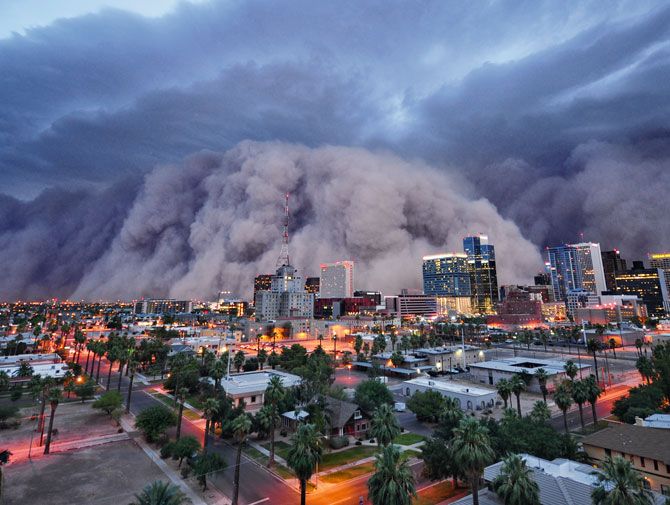
On Monday evening, chaos descended upon the city of Phoenix as a terrifying haze engulfed the area, turning the familiar desert landscape into a terrifying wall of dust.
Thank you for reading this post, don't forget to subscribe!This natural phenomenon.
characteristic of Arizona’s intense monsoon season, appeared suddenly and with frightening intensity, reducing visibility to almost zero across large areas of the city.
Residents and commuters alike found themselves in the storm’s merciless grip, their surroundings shrouded in a thick, choking haze that blanketed buildings, streets and skies.
The haboob was not an isolated event.
As it passed through Phoenix, it was quickly followed by a series of thunderstorms that produced high winds, torrential rain and lightning. These storms added to the chaos, causing widespread damage throughout the metropolitan area.
Trees were uprooted or broken, their branches fell onto streets and power lines, and debris littered neighborhoods.
The strong winds.
gusting up to 70 mph at Phoenix Sky Harbor International Airport, were particularly destructive. In a sudden response, officials had to remove a connector bridge at the airport, temporarily halting incoming and outgoing flights. As a result, airline operations were delayed by up to 30 minutes, frustrating passengers and disrupting their schedules.
Due to the intensity of the storm.
the National Weather Service issued immediate warnings for both dust storms and severe thunderstorms. The dust storm warning advised drivers to avoid travel as much as possible and to stay off the roads or park in safe locations until visibility improved. Meanwhile, the severe thunderstorm warning highlighted the threat of damaging winds and flooding.
The Arizona Department of Transportation.
(ADOT) also reiterated these warnings and reported that visibility on major highways such as Interstate 10 and Interstate 17 was significantly reduced, sometimes to less than a few feet.
Flooded roads and standing water further disrupted traffic, making travel dangerous. The storm’s impact went beyond inconvenience. More than 60,000 residents in Arizona, primarily in Maricopa County, lost power after power lines fell and infrastructure was damaged, disrupting the electrical grid.
In Gilbert, a suburb about 22 miles southeast of Phoenix.
officials responded to reports of downed traffic lights and fallen trees.Residents were urged to stay indoors and avoid unnecessary travel until conditions improve and safety is assured.
Haboobs, while common during Arizona’s summer monsoon season, are notorious for their sudden formation and imposing appearance. These high, miles-long walls of dust can often form quickly without warning and pose serious dangers to both drivers and pedestrians.
The recent storm was not an isolated incident;
it followed a dust storm over the weekend in Nevada that disrupted the famous Burning Man festival, where high winds and dust storms forced people to evacuate and events to be canceled.
Such events underscore the severity and unpredictability of desert weather events, and remind residents and visitors of nature’s immense power in this arid landscape.
The ongoing pattern of the southwest monsoon dominates Arizona’s weather, bringing persistent monsoonal moisture and high temperatures that consistently remain in the triple digits.
As summer reaches its peak.
residents of Phoenix and surrounding areas are experiencing typical monsoonal conditions, including sudden thunderstorms and heavy rainfall.
On Monday, the city received nearly a quarter-inch of rain from a severe thunderstorm, bringing There was some relief from the scorching heat.
Weather forecasts suggest that this series of sporadic storms will continue through Tuesday and Wednesday, bringing some relief from the soaring temperatures.
However, meteorologists have predicted
a change at the end of the week, indicating a transition to dry weather with less thunderstorm activity. Monsoon moisture is expected to return, leading to clearer skies and less rainfall. This change may bring some relief from humidity, but dry weather may also increase the risk of wildfires. One of the most dramatic weather events of this season occurred when a massive dust storm, locally called a haboob, passed through the metro Phoenix area.
These terrifying storms form when strong winds lift dust and debris from the desert surface and create a high wall of dust that can extend for miles.
The haboob that hit Phoenix was particularly intense, drastically reducing visibility and immersing the city in a thick cloud of dust. The storm caused widespread disruption across the region. Haboob caused thousands of residents and businesses to lose power—an estimated 57,000 homes and businesses lost power.
Strong winds gusting up to 70 mph also knocked down trees.damaging infrastructure and blocking roads.
At Sky Harbor International Airport, several flights were canceled or delayed due to the dangerous weather. The storm also damaged a vital connecting bridge, further complicating transportation and emergency response efforts. Due to the dangerous conditions, the National Weather Service issued an emergency warning, advising drivers to use caution and avoid travel during the worst of the storm.
Low visibility on major highways such as I-10 and I-17 made driving difficult, flooded roads, and debris deposits made travel treacherous. Officials urged residents to stay indoors as much as possible and prepare for continued weather disturbances during the monsoon season.
Although the storm temporarily caused chaos, it also served as a stark reminder of the powerful forces at play during Arizona’s monsoon season.
The storm that struck Phoenix on Monday was truly remarkable, capping off a tumultuous weekend that included dust storms in Nevada. This intense weather phenomenon, known as a haboob, involves powerful winds lifting and carrying huge amounts of dust and debris into the air.
The haboob in Phoenix caused visibility to drop to nearly zero, halting flights and closing roads across the city. Such storms are common in flat desert regions, where open terrain allows winds to accelerate and easily lift loose soil. Meteorologist Mark O’Malley has indicated that the forecast for the coming days includes a 40% chance of rain in metro Phoenix,